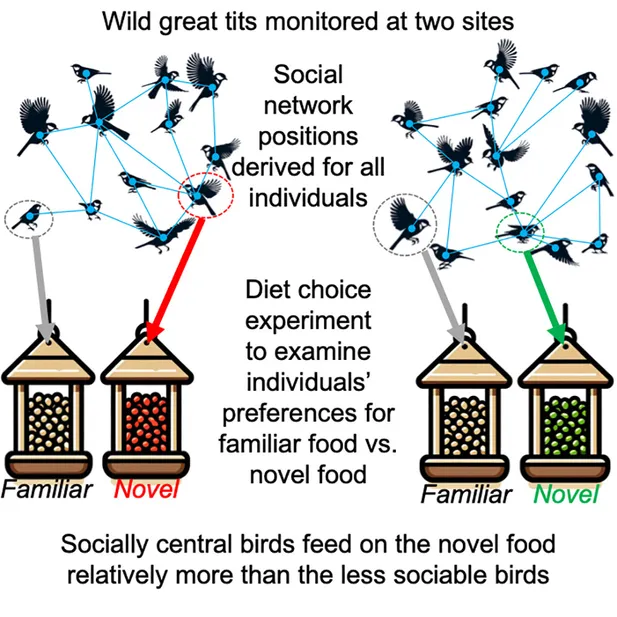Understanding the intricate balance between the advantages and challenges of group living is essential in deciphering social behavior, particularly concerning diet. Social foraging offers numerous benefits but also intensifies competition among individuals. However, social creatures have been observed to counteract this competition by diversifying their diet and exploring novel food sources. Despite the presumed correlation between social behavior and dietary choices, the precise influence of sociality on individuals’ consumption of novel foods remains largely unexplored in natural habitats.
In a groundbreaking study conducted in Wytham Woods, Oxfordshire, researchers have unveiled a fascinating correlation between the social dynamics of wild great tits and their propensity to explore novel food sources. The study, published in iScience, sheds light on the intricate interplay between social networking and foraging behaviors in avian populations. Researchers utilized advanced RFID tracking technology to monitor the movements and interactions of individual birds within their social networks.
Birds’ Social Networks Dictate Culinary Curiosity, Study Finds
Led by Dr. Keith McMahon from the Department of Biology at the University of Oxford, the research team meticulously observed 105 wild great tits as they navigated through winter foraging activities. Equipped with radio frequency identification (RFID) tags, each bird’s behavior was closely monitored, allowing researchers to dissect the intricate web of social interactions within the avian community.
Navigating Nature’s Buffet: Insights from Wytham Woods Avian Study
By analyzing the birds’ social networks – the connections they formed with fellow flock members – researchers uncovered a remarkable pattern. Highly sociable individuals, those with a greater number of social associations within their network, displayed a heightened inclination towards exploring novel food sources. This behavior was notably distinct from other factors such as age, sex, or flock size.
Intricate Interplay: Avian Sociability and Foraging Preferences Revealed
However, what’s truly intriguing is that sociability did not influence the speed at which birds initially approached the novel food source. Nearly all birds, regardless of their social inclination, eventually sampled the unfamiliar food. This suggests that sociability doesn’t necessarily correlate with exploratory tendencies but rather with a strategic adaptation to mitigate competition for resources.

Social Networking in the Wild: The Key to Avian Culinary Curiosity
Dr. McMahon remarked, “Our findings indicate that highly social birds are not inherently more exploratory or brave. Instead, their increased likelihood to utilize novel food sources serves as a strategic mechanism to diversify their diets, offsetting the challenges posed by heightened competition for resources within their social networks.”
Oxford Study Unveils Birds’ Strategic Approach to Foraging Diversity
Senior researcher Dr. Josh Firth emphasized the significance of these findings, suggesting that highly social birds may possess a unique advantage in navigating dynamic foraging landscapes. “By broadening their dietary preferences, these birds may effectively alleviate the pressures of resource competition, thus enhancing their overall foraging success,” stated Dr. Firth.
Pioneering Avian Research at University of Oxford: Decoding Social Foraging
The implications of this research extend beyond avian ecology, offering broader insights into the drivers of behavioral change in natural populations. Understanding how social environments shape dietary decisions not only enhances our understanding of animal behavior but also sheds light on the broader implications for the causes and consequences of social strategies. As researchers continue to unravel the complexities of sociality in the animal kingdom, studies like these pave the way for a deeper appreciation of the intricate dynamics that govern life in the wild. Looking ahead, the researchers envision further investigations delving into the mechanisms underlying information transmission within social networks. By unraveling the intricacies of how social individuals glean knowledge about new food sources from their peers, scientists aim to gain deeper insights into the adaptive strategies of avian communities.







